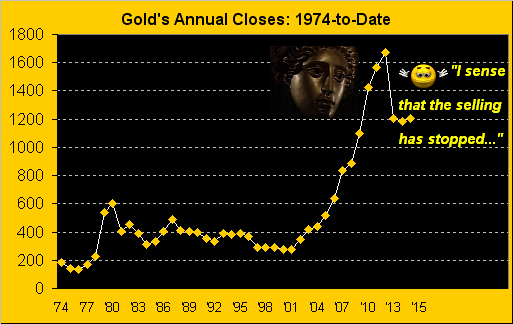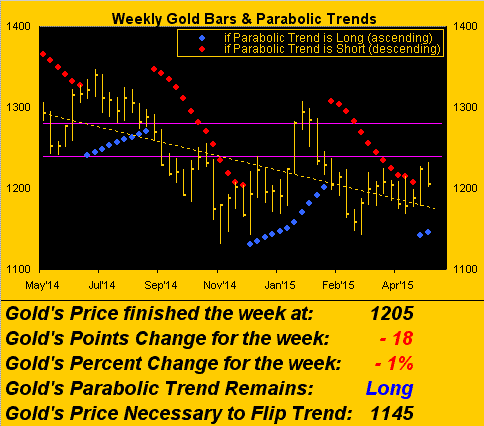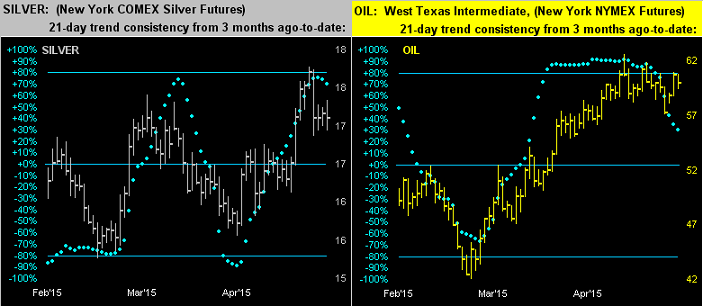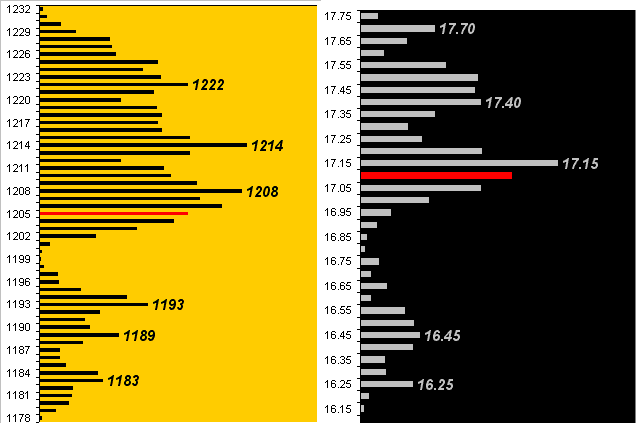To quote the fictitious, yet widely beloved, Thomas Magnum: "I know what you're thinking." Entitle this piece with the inference that gold isn't going to go down anymore, and quick as wit, 'twill summarily be flung off the cliff for a few hundred further points of free-fall. Nevertheless, some of life's best resolutions of angst -- which for us gold understanders out there in dealing daily with its dumbfoundedly depressed price -- are made manifest in a lucidly epiphanic moment. And after witnessing all that gold's been through these past four years, especially its being maniacally throttled throughout 2013, and then left quietly to assumedly bleed to death during 2014, life now at $1,200/oz. -- whilst still price-impoverished -- could be worse. Indeed, to paraphrase folk great Pete Seeger, "Where have all the sellers gone..."
And thus at last Sunday's Investors Roundtable I was struck, as if The Sybil herself was watching over me, to reiterate something that we've been hearing now and again throughout much of gold's harrowing plunge, that "the selling has stopped". We've employed that very phrase herein on several occasions, certainly over the last year. The notion is, as has been bandied about in bullionesque blogs ad infinitum, that those disposed to dispose of their gold have already so done, and thus any selling hence has essentially been via Shorting, such contract positions required to be repurchased so as to avoid obligatory delivery, "short of" instead needing to buy physical gold so as to make delivery. The point is: in my remarking that "the selling has stopped", one shot-from-the-hip Roundtable retort was "You've been saying that for a year!" True enough, and now in hindsight, 'tis been the right thing to have said. Let's start with this chart of gold's yearly closes for the last 41 years, plus the rightmost dot being 2015's present price per yesterday's (Friday's) settle of 1206:

You see? gold is today essentially where 'twas a year and a half ago at the end of 2013. To be sure, it "feels" lower, but 'tisn't. Lay that nugget of wisdom on your complacent stock market followers during this extended weekend's barbecues.
"But mmb, that annual closes picture makes it look like its totally on the edge of the cliff, man..."
And Squire, when is any market not on the edge of its cliff? For north of zero, the cliff is always but one step away, regardless of trend. As an example, might I point you to the S&P 500 Index? Here's 'tis vis-à-vis our Economic Barometer:

Yes, the Conference Board's Index of Leading Economic Indicators surprised us with a 0.7% gain for April, (the primary push coming from increases in both building permits and stock market growth, the latter being a very dubious component given its goof-ball valuation). 'Course, the good folks over there at the Board employ 10 elements in calculating their monthly LEI; the above Econ Baro uses 52. Maybe that's why one of the most commonly used economic words amongst the FinMedia is "unexpected", which may become a key adjective we'll hear following the Federal Open Market Committee's mid-June pow-wow and press conference.
What's not unexpected is gold's furthering the parabolic Long trend of the weekly bars as below shown, the second blue dot in the series having made its appearance. The interest to own some gold, (now there's an idea!) ought get a technical jump-start if price can permeate that purple-bounded 1240-1280 resistance zone such as to print a weekly bar that's clear of the upper line. Talk of gold would then upshift from the "1200s" to the "1300s"; (and talkin' in 100-point "handles" at a time is all we ask):

Turning to trend consistency, this next two-panel graphic features daily bars for the past three months-to-date for both gold (on the left) and the dollar index (on the right). We oft point out that gold plays no currency favourites, such notion being brought to light a bit here as opposed to price's being "assumed" as negatively correlated with the dollar. Notably, from about the respective panels' mid-points, gold and the dollar both went into decline, only to have since turned higher. Clearly, gold has most recently come off somewhat, however the "Baby Blues" that define each bar's level of 21-day linear regression trend consistency have nonetheless now been in ascent for both markets:

Next, in doing the same drill for silver (below left), the picture is not as nice as the "Baby Blues" have just begun to roll over. But of interest here is pairing Sister silver up with oil (below right): note how both markets in February and March were almost identically shaped, prior to oil's then being off to the races from the 40s up through the 50s and into the low 60s, whilst many were calling for the 30s. The spectre of war in the Middle East along with Arabian rumblings over supply and China all have served to buoy oil more so than the Precious Metals. But those declining blue dots on the oil panel as well are suggestive of lower levels ahead, albeit it remains to be seen if many a commodity will be dragged down in tow, (save for the Precious Metals for those "in the know"?):

As usual, some fundamental rational shall remian intact for dollar firmness, (not "strength", please...) The euro is re-slumping given a now faster-than-expected pace of stimulus from the European Central Bank, especially with respect to the "unexpected" fall in Germany's investor confidence. Across the channel, prices in the UK are truly going backward for the first time since 1960, (nature's economic way of putting Bentleys on sale). Then right 'round and down to Greece, 'tis facing a potential debt payment default come 05 June such as to press Prime Minister Alexis "Tie-less" Tsipras to inform Lady Lagarde over at the IMF that she shan't receive that which she is expecting unless Sir Draghi from the ECB, of course, rides into Athens on his white horse. Spin those €uro printing tumblers! More faux-dough for the fiscal fumblers!
So: as shown earlier, we've got gold in a fresh new parabolic weekly Long trend, along with a weakening Econ Baro that is more suggestive of eventual StateSide monetary accommodation than interest rate acceleration. And yet EuroZone weakness and "Baby Blues" peakness potentially can put "the selling has stopped" sense to the test yet again. Can the Precious Metals find supportive footing in at least their 10-day Market Profiles? Here they are on the left for gold and on the right for silver. The red bars are yesterday's respective settle prices of 1206 and 17.10:

We'll wrap it here with these two observances and a look to the week ahead.
First, the mighty JPMorgan Chase, toward getting its own read on the US economy, is launching a research unit to analyze the economic ways of some 30 million of its customers. That's a lot of customers, (practically 10% of the US population). But one has to wonder if the results will be skewed to the upside: after all, Joe "Average" Six-Pack is hardly the profile of the bank's typical customer. But then as dear old Dad used to say, in his New York way, "It pays to do banking with Chase". Whatever it takes to keep their flow of fees on the make.
Second, and this is quite abominable, a high-profile TV network featured a report (speaking of Big Banks) from goldman Sachs on the price/earnings ratio of the S&P 500. 'Twas stated that the average P/E of the 500 constituents is 18.3x. (Bob Shiller's cyclically-adjusted reading is current 27.5x; our "live" cap-weighted reading is presently 33.9x) But such broad-brushed misinformation reaching an idiot-box audience of millions borders on irresponsibility, (as much as we value our freedom of speech). So I whipped open our Excel workbook and did just the simple average P/E of the 500 stocks without regard to market capitalization: and it came in very close at 33.2x to our cap-weighted number. But then the light bulb came as to how to get it down into the 18s: assign to those companies with "negative earnings" negative P/E ratios! Et voilà! There's your 18.3x. Beyond such calculation being intuitively bassackward stoooopid, 'tis fundamentally dishonest in this writer's opinion to put such inaccuracy out there at large. Again, that's why we do the real math. If a company has negative earnings, its P/E technically is infinity; rather, we simply designate its P/E as the price of the stock, (which is a very charitable gesture), as 'tis the price one is paying for something that earns nothing. A word to the wise is sufficient.
As to the upcoming holiday-shortened week, a reasonable load of incoming Econ Data awaits us, most notably the first revision -- which is slanted to be lower -- of Q1 GDP. But to what degree shall it be "unexpected"? A downward revision ought be a shot in the arm for gold in sensing that "the selling has stopped". Mind the Econ Baro.